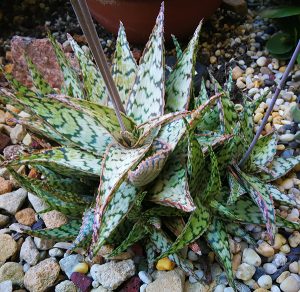
Aloe Hybrid ‘Pink Blush’
Pink Blush is a clumping Aloe, blooming from mid winter through to early spring. It enjoys morning sun and afternoon shade to look its best

Succulent Varieties » Aloe » About Aloe
Fertilise early spring through to summer if you feel the need however, most Aloes don’t require too much attention. I find my hybrids require more attention than the popular Aloe Vera variety.
It is important to remember that Aloes do not like wet feet, the soil whether it be in a garden or succulent container/pot, a very well draining medium is required. My Aloe’s are planted in 3 parts soil, 2 parts coarse sand and 1 part perlite. Spiral Aloe is very sensitive and therefore I have added a little extra perlite to ensure the best drainage. You can also use a formulated cacti and succulent soil such as Searles Cacti and Succulent soil available for any good nursery. I do not recommend Osmocote Cacti and Succulent Soil as it is full of bark and most succulents seem to need repotting much faster than usually required.
When repotting, do not tease the roots, try to retain as much soil around the roots as possible by knocking the Aloe out of the pot. The only reason you would remove excess soil is if your plant has mealy bug and in which case you will need to hose off all soil and treat the infected areas with dishwashing liquid and mentholated spirits mixed with 30% water in a spray bottle, rinse off after a few hours and then repot. Repotting can be done at any time as a general rule, they are pretty resilient plants!
It is very easy to over water Aloes, they really don’t appreciate wet feet. In the dry months it is important to keep watering at least once a week as they do like a good drink. Water only when the soil has dried out between waterings otherwise over watering can cause root rot. Reduce watering in the winter months.
Lighting conditions vary for each variety from full sun through to filtered sun. A lot of smaller hybrids enjoy filtered sun all day and definitely not hot afternoon sun as they can easily burn. You can see when an aloe is struggling in too much sun as it will either start burning or curling its leaves inwards to protect the fresh inner growth.
Aloes are opportunists. They can grow consistently throughout the year if the conditions are right. As a general rule, most Aloe varieties are somewhat dormant in the summer months. Dormancy can be triggered by so many different factors, succulents actually count the hours in the day to determine the season. If conditions fluctuate inconsistently it can result in early blooms or even no blooms at all depending on light exposure, water availability or even stress induced dormancy.
They are best propagated via stem cuttings, offsets or seeds, they cannot be propagated via leaf. Cut with a sterile knife or garden sheers and allow your cutting to callus over for at least 1 – 2 weeks before planting. In summer it is reasonable to wait only 1 week to callus before planting.
Aloes being very resilient, they are mostly pest free however can develop fungal diseases and mealy bug infestations if there is not enough airflow around the plant, if it is kept indoors and watered too regularly. Keep your soil to the top of the pot and ensure good airflow and good drainage to avoid pest infestations.
A few varieties have been used for healing purposes over the centuries, Aloe Vera can be used in drinks or cut open and used on insect bites and wounds as they have a soothing effect to insect bites and minor skin irritations. Aloe Ferox and Aloe Arborescens are also widely known for their therapeutic effects. Although some varieties are non toxic, it is important to be aware that this is not a blanket rule for all Aloe species. It is best to do your research before exposing your plant to small humans or pets.

Pink Blush is a clumping Aloe, blooming from mid winter through to early spring. It enjoys morning sun and afternoon shade to look its best
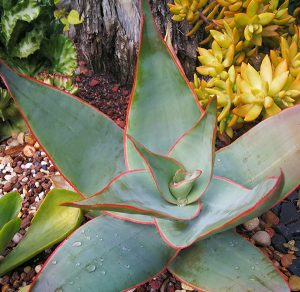
Growing up to 45cm tall and 60cm wide this is a medium sized Aloe variety and is completely ‘toothless’ and soft to the touch. The
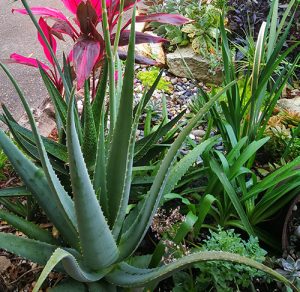
Aloe Barbadensis is the one true Aloe Vera (actually referred to as the true medicinal Aloe). Aloe Vera can grow up to 1m tall with
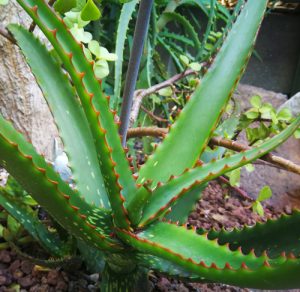
Camperi or ‘Popcorn Aloe’ is a very hardy species of Aloe, native to Ethiopia and Eritrea. It is an evergreen succulent perennial with individual leaves
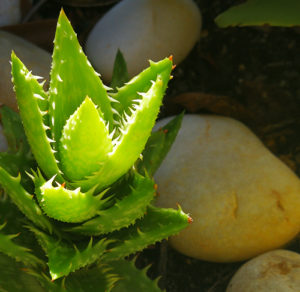
A small branching Aloe with white spots that only reaches around 30cm in height. It does best in morning sun/afternoon shade as it can be
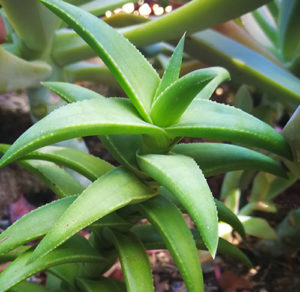
A small hybrid that generally flowers in summer. The flowers are a lovely peach colour with cream and green striped tips. They are more closely



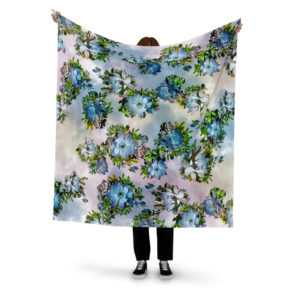
© All rights reserved